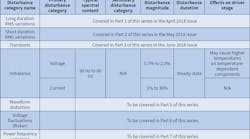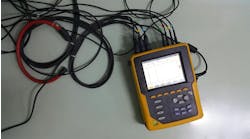This article is Part 4 of a seven-part series on the effects of power quality disturbances on a five-stage electronic LED driver. Part 1 (April 2018) dealt with long-duration voltage variations. Part 2 (May 2018) dealt with short-duration voltage variations. Part 3 (June 2018) focused on voltage and current transients (including surges). This month, we turn our attention to voltage and current imbalances. Like most voltage sags, swells, and distortion, imbalances typically do not cause destructive damage to electronic LED drivers.
There are two types of imbalances in power quality — voltage imbalances and current imbalances. Because no 3-phase electronic LED lighting systems are present in the marketplace, only single-phase, phase-to-neutral and phase-to-phase LED lighting systems are affected. The effects of voltage imbalances occurring in 3-phase facility electrical systems can cause negative impacts on these LED lighting systems. This is because LED drivers can respond negatively to long-term, under-voltage conditions. Long-term, under-voltage conditions can be caused by voltage imbalances. In addition, one of the common causes of voltage imbalance is current imbalance on 3-phase facility power systems.
Voltage imbalance is also a steady-state quantity defined as the maximum deviation from the average of the three phase voltages or currents, divided by the average of the three phase voltages or currents, expressed in percent. Imbalance can also be quantified using symmetrical components. The ratio of the negative sequence (or zero sequence) component to the positive sequence component is used to specify the percent unbalance. The negative sequence (or zero sequence) voltages in a power system generally result from imbalanced loads, causing negative sequence (or zero sequence) currents to flow. Imbalance can be characterized by a trend of the unbalance magnitude in percent versus time or can be summarized using statistics of the unbalance magnitude over some period.
The primary source of voltage imbalance less than 2% is unbalanced single-phase loads on a 3-phase circuit. Voltage imbalance can also be the result of capacitor bank anomalies, such as a blown fuse on one phase of a 3-phase bank. Severe voltage imbalance (greater than 5%) can result from single-phasing conditions. Voltage imbalance is most important for 3-phase motor loads. ANSI Std. C84.1-1989 recommends that the maximum voltage imbalance measured at the service entrance under no load conditions should be less than 3%. Imbalance greater than this can result in significant motor heating and failure if there are not protection circuits to protect the motor.
Current imbalances are typically caused by unbalanced loading of individual phases, whether the system is wye or delta connected. Loads in customer facilities are single-phase (i.e., phase-to-neutral) and 3-phase. It is easy for too many single-phase loads to be connected to a specific phase. Sometimes, electricians don’t take enough time to check to see how well the three phases in an electrical panel are balanced. Current imbalances can also be caused by malfunction of 3-phase loads, especially if one or more parts of the 3-phase load is not drawing its rated current. Electricians should strive to keep the phase currents balanced in 3-phase electrical systems. Customers should avoid connecting high-current, single-phase loads to branch circuits without consulting an electrician. One good example of a single-phase load that may cause a current imbalance is a copy machine.
Another cause of current imbalance can stem from the misapplication of circuit breakers to protect the branch circuits used to power 3-phase electrical and electronic equipment. In some cases, electricians will use a mix of single- and double-pole breakers to protect 3-phase branch circuits instead of using a properly rated 3-phase breaker. When this occurs, one or more phase conductors in a 3-phase branch circuit may be “electrically” allowed to carry more current than the conductor (or conduction installation) can safely support. This can cause the voltage on one or more phases to be pulled down, thus causing a 3-phase current imbalance, which, in turn, causes a 3-phase voltage imbalance if the voltage is impacted too much.
The Table provides the category breakdown and all technical specifications for the voltage and current imbalances discussed above.
Effects of voltage imbalances on LED drivers
As mentioned above, voltage imbalances on LED drivers powered from single-phase (i.e., phase-to-neutral) and phase-to-phase circuits can cause negative impacts on the performance of the driver and its LED light engine. In a single-phase application, the driver phase-to-neutral voltage simply “feels” the effects of the low-voltage condition. If the low-voltage condition is within the ANSI/IEEE limit of +/- 10% of the nominal line voltage, the driver should not malfunction. However, specific components in the driver may start to overheat within the 10% tolerance range. These components are typically associated with the front-end circuitry such as line inductors (or chokes) associated with electromagnetic interference (EMI) filters, the bridge rectifier, and other components associated with the active power factor correction (APFC) circuitry.
Electronic designers know that when such components experience higher-than-normal temperature conditions, the life of these components is most likely always shortened. Moreover, components with higher-than-normal operating temperatures cause the overall LED driver’s temperature to increase.
At some low-voltage point (hopefully after the +/-10% tolerance range), the DC bus voltage produced by the APFC circuitry will start to drop. When this occurs, the performance of the DC-to-AC inverter stage may experience performance problems.
In delta-configured power systems, a voltage imbalance can cause one or more phase voltages in a phase-to-phase system to increase. This will cause a long-term, high-voltage steady-state condition. When such conditions occur, components in the front-end circuits of drivers will also experience heating and voltage stress, possibly reducing the life of these components as well.
Looking at some real-world examples of voltage imbalances, examine the Figure below. As a power quality community, we know that the left figure shows a trend of the zero-sequence voltage imbalance for an industrial customer during a one-week period. You’ll notice that the voltage imbalance is generally about 0.5% on average and that disturbance conditions (see the vertical blue dotted lines) cause sudden increases in imbalance. The right figure shows a trend of the negative-sequence voltage imbalance for the same industrial customer during the same one-week period. This imbalance is typically slightly less than 0.5%. However, there is one period Friday evening when the imbalance reaches 1%. You will also notice that the shapes of the imbalance trends between the zero-sequence and negative-sequence are also significantly different.
Keebler is a senior power quality engineer and power systems consultant at Electrotek Concepts, Inc. in Knoxville, Tenn. He can be reached at [email protected].





